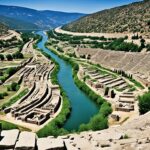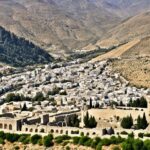Welcome to our exploration of the Tribe of Dan in the Bible. This ancient Hebrew tribe, sometimes spelled as “Dann,” holds a significant place in biblical history and is mentioned in various religious texts. Join us as we dive into the intriguing story of Dan and uncover the mysteries surrounding this tribe.
The Tribe of Dan was one of the twelve Tribes of Israel according to the Torah. As the second largest Israelite tribe, Dan played a crucial role in the history of Israel. From their geographical location to their archaeological discoveries, we will uncover all the fascinating details about this tribe and its impact on biblical narratives.
Key Takeaways:
- The Tribe of Dan was one of the twelve Tribes of Israel.
- They were allocated a region to the north of the Galilee and west of the Jordan.
- Dan joined the Northern Kingdom after the split of the kingdom.
- After the kingdom was conquered by Assyria, the Tribe of Dan became one of the Ten Lost Tribes of Israel.
- Archaeological discoveries have provided insights into the history of the Tribe of Dan.
Historical Significance of the Tribe of Dan
The Tribe of Dan holds an important place in the history of Israel, playing a significant role in various biblical events and narratives. As one of the largest tribes during the conquest of Canaan, they were part of a loose confederation of Israelite tribes. Their story unfolds within the pages of the Hebrew Bible, offering valuable insights into their journey and the impact they had on the nation of Israel.
After the conquest of Canaan, the Tribe of Dan contributed to the formation of the first Kingdom of Israel. When Saul became the first king, they joined the new kingdom, and after his death, they stood alongside the other northern Israelite tribes in making David the king of a reunited Kingdom of Israel. Their support and cooperation were crucial in unifying the divided nation and establishing David’s dynasty.
However, the Tribe of Dan’s story took a different turn after the kingdom was conquered by Assyria. Along with other Israelite tribes, they were counted among the Ten Lost Tribes of Israel. Their descendants became scattered, and their historical presence diminished over time. Yet, the historical significance of the Tribe of Dan in shaping the early history of Israel cannot be overlooked.
Key Events Involving the Tribe of Dan:
- The tribe’s participation in the conquest of Canaan
- Journey to the north and establishment of the city of Dan
- Involvement in the political landscape of Israel, supporting the kingship of Saul and David
- Loss and scattering of the tribe after the Assyrian conquest
The historical significance of the Tribe of Dan provides a fascinating glimpse into the complex history of ancient Israel and the role of different tribes in shaping the destiny of the nation.
Geographical Location of the Tribe of Dan
The Tribe of Dan, one of the twelve tribes of Israel, was allocated a specific geographical region. Their territory was located to the north of the Galilee and west of the Jordan, making it the most northerly part of the Promised Land.
The main city of the Tribe of Dan was originally known as Laish, but the tribe renamed it Dan in honor of their forefather. This city served as their capital and played a significant role in their history and identity.
The tribe initially attempted to settle in the central coastal area of Palestine. However, due to ongoing hostility with the Philistines, they made the decision to migrate to the northern part of the country.
“We conquered Laish and made it our own. It became a symbol of our strength and resilience as the Tribe of Dan.”
Conquering Laish proved to be a pivotal moment for the Tribe of Dan. It solidified their presence in the land and established their unique identity within the larger Israelite community.
In modern times, the region historically inhabited by the Tribe of Dan is known as Gush Dan, a term derived from their name. This region holds both historical and cultural significance as it preserves the legacy and heritage of the Tribe of Dan.
Geographical Overview of the Tribe of Dan
| Geographical Region | Main City | Modern Name |
|---|---|---|
| To the north of the Galilee and west of the Jordan | Dan | Gush Dan |
Archaeological Discoveries Related to the Tribe of Dan
Archaeological excavations in the region of Dan, the main city of the Tribe of Dan, have unearthed valuable insights into the history and existence of this ancient tribe. These discoveries provide tangible evidence of the presence of the Danites in the land of Canaan.
“The archaeological findings in the region of Dan have shed light on the rich heritage and traditions of the Tribe of Dan. These artifacts help us understand the daily lives, customs, and cultural practices of the Danites.”
The excavations have revealed remains of ancient settlements and a wide array of Danite artifacts, including pottery, tools, weapons, and religious objects. These findings not only confirm the existence of the tribe but also provide a glimpse into their material culture and way of life.
One remarkable discovery is the Danite cultic site at Tel Dan, featuring a monumental gate structure and a large stone fragment with an ancient inscription mentioning the “House of David.” This inscription has significant historical and biblical importance, as it provides evidence for the existence of King David from the House of David, as mentioned in the biblical texts.
Furthermore, the archaeological evidence supports the biblical accounts of the tribe’s migration from the central coastal area to the north. The ancient city of Laish, which the Danites conquered and renamed Dan, is a prime example of their settlement and presence in the region.
| Archaeological Findings | Description | Significance |
|---|---|---|
| Danite pottery | Fragments of ceramic vessels used by the Danites for various purposes, including cooking, storage, and religious rituals. | Offers insights into their daily lives, technological advancements, and artistic expressions. |
| Danite weapons | Arrowheads, spearheads, and other military implements used by the Danites for self-defense and warfare. | Highlights their military capabilities and the challenges they faced in a region marked by conflicts and rivalries. |
| Danite religious artifacts | Idols, figurines, and other objects associated with the Danite religious practices and beliefs. | Provides insight into their spiritual and religious worldview, offering a glimpse into their rituals and religious customs. |
The Tribe of Dan’s archaeological discoveries not only contribute to our understanding of their history but also shed light on the broader cultural, social, and religious contexts of the ancient Israelite tribes. By studying these artifacts and sites, archaeologists and historians continue to piece together the fascinating story of the Tribe of Dan and their place in the tapestry of biblical and ancient Near Eastern history.
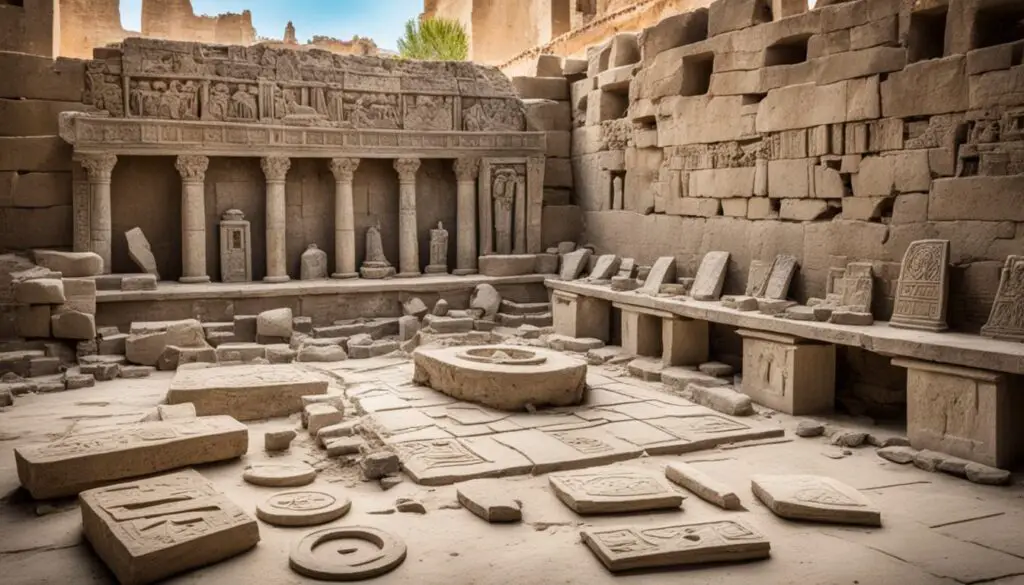
Theological Themes Associated with the Tribe of Dan
The Tribe of Dan holds significant theological significance in various religious texts and prophecies. One such mention of Dan can be found in the Blessing of Moses, where Dan is seemingly prophesied to leap from Bashan, despite the tribe not being recorded as ever residing in that area. This prophecy has sparked debates among scholars regarding its meaning and implications.
“Dan shall leap from Bashan.” – Deuteronomy 33:22
Additionally, the tribe’s role in the history of Israel, particularly their eventual scattering and loss, carries theological implications that contribute to the overall narrative of the Hebrew Bible. Their inclusion in the biblical accounts, despite their eventual disappearance, speaks to the larger themes of divine providence and the fulfillment of prophecies.
Through their presence in religious texts and their role in biblical prophecies, the Tribe of Dan offers intriguing insights into the intricate tapestry of the divine plan and serves as a reminder of the profound spiritual depth embedded within the biblical narratives.
Dan in Religious Texts
References to the Tribe of Dan can be found in various religious texts, including the Hebrew Bible. While their prominence may not match that of other tribes, their presence and participation in key events highlight their significance within the larger historical and theological context.
Dan in Biblical Prophecies
Biblical prophecies often mention the Tribe of Dan, alluding to their future or symbolic role in shaping the destiny of Israel. The prophecy of Dan’s leap from Bashan suggests a significant turning point, emphasizing the tribe’s relevance in key moments of Israel’s history.
As we dive deeper into the biblical accounts and explore the prophetic messages related to the Tribe of Dan, a more comprehensive understanding of their role in the unfolding divine plan begins to emerge.
Key Biblical Events Involving the Tribe of Dan
The Tribe of Dan played a significant role in several key biblical events throughout the history of Israel. Let’s explore some of these important moments:
The Conquest of Canaan
When the Israelites set out to conquer the Promised Land, the Tribe of Dan was among the tribes at the forefront of this military campaign. They participated in the battles and strategic maneuvers that led to the establishment of Israelite control over Canaan.
The Settlement of the Promised Land
After the conquest, the land was divided among the twelve tribes of Israel. The Tribe of Dan received its allotted portion, which was in the northern region of Canaan, to the north of the Galilee and west of the Jordan. This land became the home of the Tribe of Dan and played a crucial role in shaping their history and identity.
The Migration to the North
While initially settling in the central coastal area of Palestine, the Tribe of Dan faced constant conflict with the Philistines. As a result, they made the decision to migrate to the north of the country in search of safer territory. This migration had profound implications for the tribe and contributed to the eventual conquest of their new capital city, which leads us to the next key event.
The Conquest of Laish
Determined to find a new stronghold, the Tribe of Dan launched a successful military campaign against the city of Laish. They conquered the city and renamed it Dan, in honor of their tribal patriarch. This conquest solidified their presence in the northern region and established Dan as their new capital city.
Danite Leaders
Throughout the biblical narrative, leaders emerged from within the ranks of the Tribe of Dan. These leaders played significant roles in shaping the political and religious landscape of Israel. Names such as Samson, who possessed great strength and led the fight against the Philistines, are among the distinguished Danite leaders remembered in the biblical accounts.
These key biblical events involving the Tribe of Dan showcase their active participation in the history of Israel and the profound impact they had on the political and religious landscape of the time.
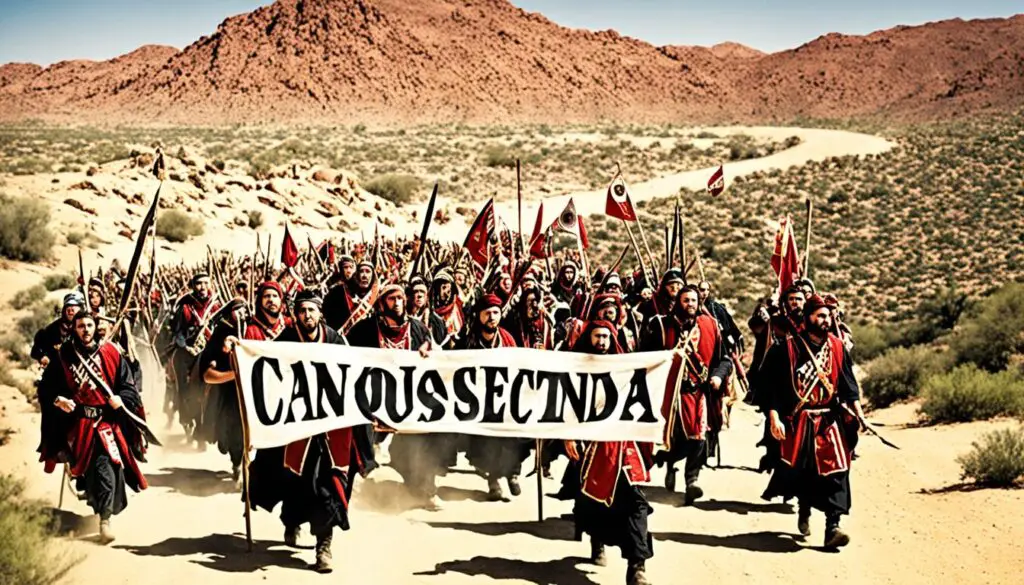
| Biblical Event | Significance |
|---|---|
| Conquest of Canaan | Established Israelite control over the Promised Land. |
| Settlement of the Promised Land | Received an allotted portion in the northern region of Canaan. |
| The Migration to the North | Allowed the tribe to find safer territory away from Philistine conflict. |
| Conquest of Laish | Established Dan as the new capital city and solidified their presence in the north. |
| Danite Leaders | Played key roles in shaping the political and religious landscape of Israel. |
Cultural and Religious Practices of the Tribe of Dan
The Tribe of Dan, as part of the Israelite tribes, would have followed the customs and rituals outlined in the Torah. However, specific practices and traditions associated with the tribe itself are not extensively documented in historical records or biblical texts.
While we don’t have detailed information on Danite culture and religious practices, we can assume that they shared many similarities with other Israelite tribes when it came to their worship, celebrations, and daily life. The Torah provided guidelines for all the Israelites to follow, including laws related to worship, sacrifices, festivals, and social interactions.
It is likely that the Tribe of Dan participated in the major religious observances such as Passover, Shavuot, and Sukkot, as well as the pilgrimage to the Tabernacle or later the Temple in Jerusalem. They would have practiced circumcision, observed the Sabbath, and followed the dietary laws outlined in the Torah.
As with any ancient culture, there may have been additional customs and traditions that were specific to the Tribe of Dan. Unfortunately, due to the limited historical records available, we can only speculate about these unique practices.

Prophetic and Eschatological Significance of the Tribe of Dan
The Tribe of Dan has long been a subject of speculation and interpretation in prophetic and eschatological discussions. Many religious scholars believe that this ancient tribe holds significant importance in future events, particularly in the end times. At the same time, others interpret the scattering and loss of the tribe as symbolic of spiritual teachings or historical fulfillments. The precise eschatological significance of the Tribe of Dan remains a topic of ongoing debate and interpretation.
“And of Dan, he said: ‘Dan is a lion’s cub, springing forth from Bashan.’” (Deuteronomy 33:22)
The above prophecy from the Blessing of Moses has intrigued scholars, as it mentions Dan leaping from Bashan, despite the tribe not being recorded as residing in that area. Some interpret this verse as an indication of Dan’s role in future events, utilizing the lion symbolism to suggest their strength and prominence. However, the interpretation of this prophecy and its connection to the tribe’s eschatological significance remains a matter of interpretation.
Another aspect worth considering is the historical scattering and loss of the Tribe of Dan, which has led to various theories about their role in the end times. Some suggest that their absence among the restored tribes of Israel could signify an exclusive calling or a hidden purpose yet to be revealed. However, it is essential to approach these interpretations with caution, as eschatological predictions are subject to diverse understandings and perspectives.
While the Tribe of Dan’s prophetic and eschatological significance may elicit curiosity and inspire theological discussions, it is crucial to acknowledge that specific details and interpretations remain speculative and open to individual perspectives. Exploring the role and fate of the Tribe of Dan in the context of end-time events can contribute to a deeper appreciation of biblical eschatology, offering insights into the complex tapestry of God’s plan for humanity.

Tribe of Dan Prophecies and Eschatology
Several biblical passages have been associated with the Tribe of Dan and its potential role in eschatological events. These prophecies, along with their interpretations, have contributed to the ongoing discussions surrounding the tribe’s significance in the end times:
- The Blessing of Moses (Deuteronomy 33:22): As mentioned earlier, this prophecy has generated speculation about Dan’s future, with the lion’s cub symbolism hinting at their prominence.
- The Book of Revelation (Revelation 7:4-8): Some interpreters associate the mention of the Tribe of Dan’s exclusion from the list of sealed tribes as a sign of their distinct future positioning or even a symbolic representation of a faithful remnant.
- The Book of Ezekiel (Ezekiel 48:1-2): In the prophetical vision of the future division of the land, Dan is granted an inheritance, creating intrigue as to their involvement in the eschatological era.
These prophecies and their related interpretations contribute to the ongoing exploration of the Tribe of Dan’s potential role in end-time events. However, it is essential to approach these discussions with open-mindedness, recognizing the speculative nature of eschatological interpretations and the varying viewpoints within theological discourse.
| Prophecy | Interpretation |
|---|---|
| The Blessing of Moses (Deuteronomy 33:22) | Significance of Dan’s strength and prominence in future events. |
| The Book of Revelation (Revelation 7:4-8) | Potential symbolism of Dan’s exclusion or representation of a faithful remnant. |
| The Book of Ezekiel (Ezekiel 48:1-2) | Granting of an inheritance to Dan in the future division of the land. |
Legacy of the Tribe of Dan
The Tribe of Dan, despite being counted among the Ten Lost Tribes, has left a lasting legacy. Their presence and influence in the land of Canaan, as well as their contributions to the history of Israel, are important aspects of ancient Israelite culture and identity. The descendants of the Tribe of Dan have likely merged with other populations over time, making it difficult to trace their specific lineage.
Nonetheless, the tribe’s legacy and its impact on biblical narratives and religious traditions continue to resonate. The Tribe of Dan played a significant role in the history of Israel, participating in the conquest of Canaan and settling the Promised Land. Their migration to the north and the establishment of their capital city, Dan, demonstrate their determination and resilience.
“The Tribe of Dan’s presence and influence in Canaan contributed to the rich tapestry of ancient Israelite culture and history.”
The Tribe of Dan also played a part in the political and religious landscape of Israel, with prominent leaders emerging from their ranks. While the tribe may have experienced challenges and eventual scattering, their enduring legacy can be seen in the archaeological discoveries of their ancient settlements and artifacts. These findings provide tangible evidence of their existence and activities in the land.
Furthermore, the Tribe of Dan’s theological significance cannot be overlooked. References to Dan in religious texts and prophecies add depth to the narrative of the Hebrew Bible. Although the precise eschatological significance of the tribe remains a topic of debate, their role in biblical events and their eventual dispersal hold spiritual and historical lessons.
Overall, the legacy of the Tribe of Dan endures through their historical impact, cultural contributions, and religious significance. While the specific path of their descendants may be uncertain, their story continues to captivate and inspire, reminding us of the enduring influence of the ancient Israelite tribes.
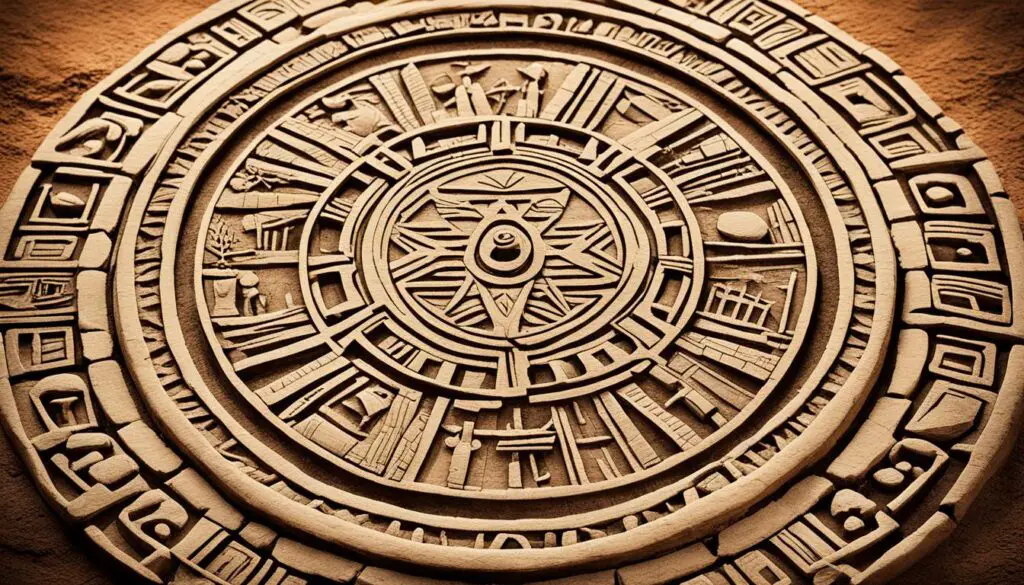
Influential Figures from the Tribe of Dan:
- Samson: A renowned judge of Israel known for his extraordinary strength and courage.
- Hiram: An artisan who played a crucial role in the construction of the Temple of Solomon.
- Jeroboam: The first king of the northern Kingdom of Israel, which included the Tribe of Dan.
Conclusion
The Tribe of Dan’s role in the Bible is a fascinating subject that offers valuable insights into ancient Israelite history and religious beliefs. Through an exploration of their history, geographical location, archaeological discoveries, theological themes, key biblical events, cultural practices, prophetic significance, and legacy, we can gain a deeper understanding of this tribe’s significance.
Although many details about the Tribe of Dan remain uncertain or speculative, the study of Dan in the Bible reveals a multifaceted narrative that enriches our understanding of the broader Israelite story. The tribe’s migration, conquests, and political involvement contribute to the intricate tapestry of biblical events and themes.
Furthermore, the Tribe of Dan’s legacy extends beyond their status as one of the Ten Lost Tribes. Their impact on ancient Israelite culture and identity is still felt today, despite the challenges in tracing their specific lineage. Exploring the various aspects of Dan in the Bible provides invaluable insights and a deeper appreciation for the rich history and religious traditions of the Israelite people.
FAQ
Who was Dan in the Bible?
Dan was one of the twelve Tribes of Israel according to the Torah. They were allocated the most northerly region, west of the Jordan river.
What is the historical significance of the Tribe of Dan?
The Tribe of Dan played a significant role in the history of Israel, being one of the largest tribes during the conquest of Canaan and joining the new kingdom after the death of Saul.
Where was the Tribe of Dan located?
The Tribe of Dan was allocated the most northerly region, to the north of the Galilee, with their main city being Laish, which they renamed to Dan.
What archaeological discoveries are related to the Tribe of Dan?
Excavations in the region of Dan, the tribe’s main city, have revealed remains of ancient settlements and artifacts, confirming the tribe’s presence in the land of Canaan.
What theological themes are associated with the Tribe of Dan?
The Tribe of Dan is mentioned in religious texts and prophecies, and their role in the history of Israel and subsequent loss has theological implications and contributes to the overall narrative of the Hebrew Bible.
What key biblical events involved the Tribe of Dan?
The Tribe of Dan was involved in the conquest of Canaan, their migration to the north and the conquest of Laish, as well as playing a role in the political and religious landscape of Israel.
What were the cultural and religious practices of the Tribe of Dan?
While the tribe followed the customs and rituals outlined in the Torah, specific practices and traditions associated with the Tribe of Dan itself are not extensively documented.
What is the prophetic and eschatological significance of the Tribe of Dan?
There are various interpretations and speculations regarding the tribe’s significance in future events and the scattering and loss of the tribe can be seen as symbolic or historically fulfilled.
What is the legacy of the Tribe of Dan?
The Tribe of Dan has left a lasting legacy through their presence and influence in the land of Canaan, as well as their contributions to the history of Israel and biblical narratives and religious traditions.
What are some insights on Dan in the Bible?
Exploring the Tribe of Dan in the Bible provides valuable insights into ancient Israelite history, religious beliefs, and the rich tapestry of their culture and identity.





